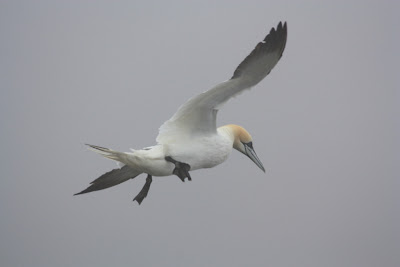First port of call is the Keen of Hamar National Nature Reserve. The directions to which might as well read "just turn right at the bus stop, you can't miss it. That's the bus stop, not the reserve". More on the bus stop later. Keen of Hamar is, at first glance, a "barren, bleak and lifeless rocky desert" and that's a quote from the Scottish Natural Heritage information leaflet! But this lunar landscape is home to some of the rarest flora in the UK, a veritable botanical gold mine. The stony ground, a debris field of serpentine rock, has a fragile carpet of tiny plants which have evolved to survive in this harsh environment where they don't have to compete with more normal flowers and grasses.
The star of the show is Edmondston's Chickweed (Shetland Mouse-ear) which is endemic to Unst and discovered by the 12-year-old Thomas Edmondston in 1837. Take a moment to contemplate that... this tiny flower grows nowhere else in the world, except on this small, desolate, north-facing slope. We were nervous about even walking around the reserve, in case we inadvertently brought about its irretrievable extinction. Other treasures included Northern Rock Cress, Norwegian Sandwort, Mountain Everlasting, Frog Orchid and Moonwort.
 |
| Edmondston's Chickweed (flower approx 20mm across) |
 |
| This is the closest our lass has ever come to smiling at football |
After a most pleasant lunch in the Northern Lights cafe in Haroldswick, we headed for another NNR, this time the seabird colony at Hermaness. From the car park, we trekked across the moor to the west side of the island and the cliffs that support 100,000 pairs of breeding birds in the summer months. These include 12,000 Gannets, 25,000 Puffins, 14,000 Fulmars, 20,000 Guillemots, as well as numerous Razorbills, Kittiwakes, Bonxies, Shags, and Arctic Skuas. I'm afraid we can't vouch for any of this, for although we could certainly hear them and most definitely smell them, due to low cloud, we couldn't actually see them. At the risk of repeating myself, "Shag!" Occasionally, a gannet would emerge out of the gloom, balancing on the wind to hang in front of us before disappearing into the fog once more.
 |
| Gannets in the mist |
 |
| Bl**dy glad I brought the Factor 30 sun cream! |
Following a picnic tea by the shore at Baltasound, we had a wander along the coast. Here we were brought up sharply by what we found. A stark reminder that despite the idyllic scenery and fantastic community spirit that exists in these islands, unless at all times we are on our guard to the dangers, there is always space for that insidious and destructive force known as peer pressure...
I had to apply for a licence from the Guild of Grammatical Pedants for special dispensation to work in that typo.


3 comments:
Great stories, and a photo of the Gannet.
Thanks, Bob. As can be detected from the photos, the weather wasn't great, borderline on requiring thermals! But it's such a wild place, both in terms of the terrain and the natural history. I hope I'm doing it justice with my ramblings.
The ramblings paint a lovely picture of a wild land and provide much amusement. I shall have to add the area to my To Do list.. just maybe not the monthly edition!
Post a Comment